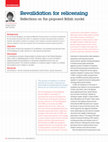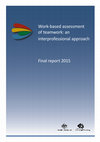Papers by Jill Thistlethwaite
British Journal of General Practice, 2005
first patient to use a portable blood sugar monitor, and through careful self experimentation he ... more first patient to use a portable blood sugar monitor, and through careful self experimentation he managed to reverse most of his diabetic complications. He has developed a comprehensive educational course that turns normal patients into highly competent self carers with truly normal blood sugars round the clock. How long can we as a profession afford to keep our heads in the sand regarding the benefits of low carb diets for diabetics?
British Journal of General Practice, 2005
Professionalism in Medicine
Australian Family Physician, 2009
British Journal of General Practice, 2004

Australian family physician, 2007
BACKGROUND Clinical breast examination (CBE) is often offered as a component of the well woman ch... more BACKGROUND Clinical breast examination (CBE) is often offered as a component of the well woman check or carried out at the request of an asymptomatic woman. In these cases the examination is a screening procedure, as opposed to a diagnostic CBE in a symptomatic woman. OBJECTIVE This article examines the evidence for screening CBE. DISCUSSION Screening CBE should involve informed consent. A negative examination does not exclude the presence of breast cancer and women should be aware of this. There have been no randomised controlled trials of CBE alone, only trials comparing CBE with mammography for the detection of breast cancer. While there is a low sensitivity (54%) for CBE, the specificity is high (94%). It is unlikely that these figures are discussed with patients. There are different methods of CBE, and these are described in the literature without a firm evidence base as to effectiveness. However, evidence does suggest that practice on models and retraining help improve clinici...

Australian family physician, 2012
BACKGROUND In the United Kingdom, the General Medical Council aims to introduce revalidation for ... more BACKGROUND In the United Kingdom, the General Medical Council aims to introduce revalidation for all medical doctors from 2012, in response to public and government pressure. Doctors will submit evidence to support their fitness to practise medicine every 5 years in relation to the four domains and 12 attributes of good medical practice. OBJECTIVE This article reviews the argument for revalidation, the proposed process and some of the findings of a pilot carried out with general practitioners. DISCUSSION A revalidation process is being piloted in several parts of the United Kingdom with a view to implementation in 2012. However, there is a lack of evidence internationally that revalidation or relicensure identifies doctors who are performing poorly. The medical profession in Australia needs to reflect on whether this model is one it wishes to consider.
British Journal of General Practice, 2002
Focus on health professional education : a multi-disciplinary journal, 2007
With the increasing complexity of health care there is a recognition that to provide safe, effect... more With the increasing complexity of health care there is a recognition that to provide safe, effective, and efficient care an Interprofessional collaborative team approach is required (Canada Health 2004; Institute of Medicine 2003). Given this focus on teamwork, there is strong international interest to incorporate interprofessional learning (IPL) into the curriculum of health care university programs to better prepare students for future practice, with the ultimate aim of enhancing the quality of service delivery and improving patient/ client care outcomes.
The global interprofessional education (IPE) community is expanding. However too frequently nativ... more The global interprofessional education (IPE) community is expanding. However too frequently native English speakers like myself confine ourselves to literature in English and have little awareness of what has been going on for some time in countries under-represented in the English language journals. This deficiency has been highlighted for me not only by the richness of the papers in this special edition of the GMS Journal for Medical Education but also by my recent experiences co-editing a series of books on leadership for IPE and my travels outside Australia and the UK. The books include chapters from Indonesia, Japan, Malaysia, India, the Philippines, Kenya and South Africa as well as the more frequently published countries such as the US, UK, Australia, New Zealand and Canada [1], [2], [3].

Clinical breast examination (CBE) is often offered as a component of the well woman check or carr... more Clinical breast examination (CBE) is often offered as a component of the well woman check or carried out at the request of an asymptomatic woman. In these cases the examination is a screening procedure, as opposed to a diagnostic CBE in a symptomatic woman. This article examines the evidence for screening CBE. Screening CBE should involve informed consent. A negative examination does not exclude the presence of breast cancer and women should be aware of this. There have been no randomised controlled trials of CBE alone, only trials comparing CBE with mammography for the detection of breast cancer. While there is a low sensitivity (54%) for CBE, the specificity is high (94%). It is unlikely that these figures are discussed with patients. There are different methods of CBE, and these are described in the literature without a firm evidence base as to effectiveness. However, evidence does suggest that practice on models and retraining help improve clinicians' skills.

D at ab as e, S ea rc h Sy nt ax a nd L im ite rs H AR VA RD IS I W eb o f Kn ow le dg e To pi c=... more D at ab as e, S ea rc h Sy nt ax a nd L im ite rs H AR VA RD IS I W eb o f Kn ow le dg e To pi c= (te am ) A N D To pi c= (te am w or k) O R To pi c= (“ w or k gr ou ps ”) A N D To pi c= (c ol la bo ra tio n) A N D To pi c= (s ur ve y) A N D To pi c= (q ue sti on na ire ) Ti m es pa n= 20 11 -0 101 20 12 -1 105 . D at ab as es =S CI -E XP AN DE D, S SC I. Le m m ati za tio n= O ff 36 7 CI HC CI N AH L M W ( in te rpr of es si on * or in te rp ro fe ss io n* o r i nt er -d is ci pl in * or in te rd is ci pl in * or in te roc cu pa tio n* o r i nt er oc cu pa tio n* o r i nt er -in sti tu tio n* or in te r i ns tit uti on o r i nt er -d ep ar tm en t* o r i nt er de pa rt m en t* o r i nt er -o rg an iza tio n* o r i nt er or ga ni za tio n* o r i nt er -o rg an is ati on * or in te ro rg an is ati on * or m ul tipr of es si on * or m ul tip ro fe ss io n* o r m ul tidi sc ip lin * or m ul tid is ci pl in * or m ul tioc cu pa tio n* o r m ul tio cc up ati on * or m ul tiin sti tu tio ...

[Extract] Aims: This project explored the learning and support needs of rural preceptors of under... more [Extract] Aims: This project explored the learning and support needs of rural preceptors of undergraduate medical students from the James Cook University School of Medicine, including rural clinicians, General Practitioners and allied health professionals, to identify the preferred options for delivery and feedback, and to develop an integrated and self-sustaining approach. Recommendations are made to improve quality locally, which should be of relevance to other settings. Methodology: The program was evaluated using both qualitative and quantitative means. The primary methodology was qualitative, reflecting the need to evaluate perceptions of the preceptors regarding their preparation, support and reward needs, the perceptions of both the preceptor and students regarding the teaching/learning environment on rural placements, and identifies how these needs may be more appropriately delivered in future years. Conclusions and key recommendations: Both qualitative and quantitative components of the needs analysis strongly indicated that despite not receiving formal preparation for their teaching responsibilities, the great majority of rural preceptors provided students with a positive teaching/learning environment on rural placements. Preceptors made many suggestions regarding their preparation, support and reward needs, and how these could be most appropriately delivered. The most important of these included: 1. Student feedback of the preceptor's teaching strategies is highly desired by preceptors. However, because of their time constraints, preceptors wanted education and training to be organized only if the student feedback showed it was required, and the associated education and training must be delivered appropriate to the preceptor's preferences. Student feedback should be undertaken every few years, and summarized results delivered at yearly conferences and/or by personal communication if specific teaching issues identified.2. Students should bring information to the rural preceptor about their personal interests and Faculty expectations, current and previous curriculum/organ systems under investigation, aims/learning objectives of rural placement, and desired practical learning activities. 3. Faculty should ensure students who are sent out to rural placement sites have sufficient training in common clinical procedures, necessary equipment, enthusiasm, and good understanding of the personal behaviours and cultural and confidentiality issues that are expected and appropriate in rural and remote areas. 4. Teaching/learning experiences are significantly enhanced if specific resources are available at the rural teaching facilities, including: spare rooms at the rural placement site where students can be given tutorials and examine patients by themselves; access to approved medical education websites and textbooks; and Faculty-appointed administration staff in the rural site to organize and deliver varied learning activities.5. Rural preceptors are not only very different individually, but they also work in very different medical facilities and live in very different rural communities; therefore, Faculty should liaise closely with each individual preceptor to determine and deliver the student feedback, preparation, support and rewards desired by each, and listen to and act on their concerns and suggestions.

Final report from a project that addressed the nationally recognized need to develop and deliver ... more Final report from a project that addressed the nationally recognized need to develop and deliver a robust package of work-based assessment (WBA) tools for health professional students in diverse clinical settings as a means of testing their teamwork competencies and interprofessional collaboration in the workplace. Teamwork competencies are included as both graduate attributes in general and in healthcare curricula in particular but are rarely assessed. The project provided an assessment framework that not only assesses students individually as team members but also considers a team as a single entity with a view to enhancing team performance. This partnership of four Australian and one Canadian university reviewed and evaluated existing WBA tools for teamwork across the health professions and developed a framework and instruments for formative assessment that are valid, reliable, feasible and suitable for the provision of timely and constructive feedback to students.;
Journal of Interprofessional Care

Uploads
Papers by Jill Thistlethwaite